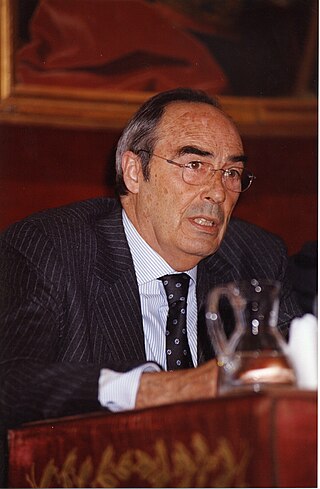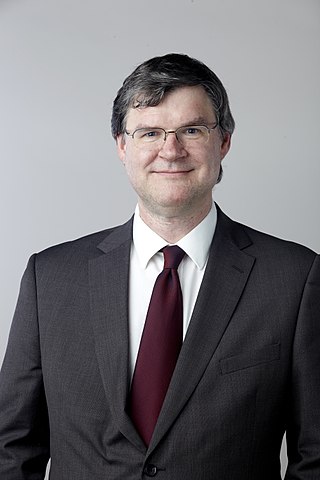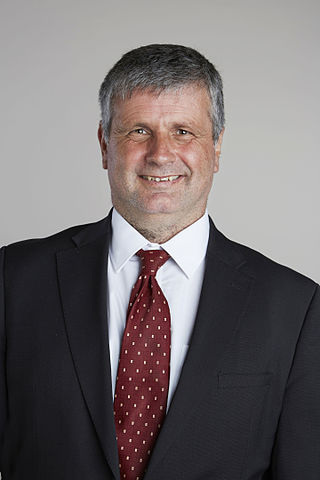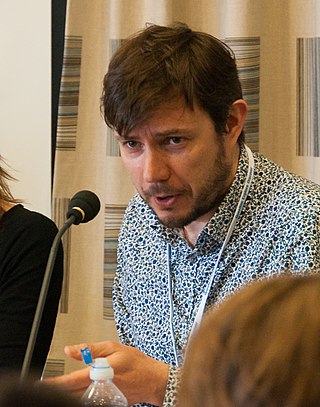Related Research Articles

In theoretical physics, quantum chromodynamics (QCD) is the theory of the strong interaction between quarks mediated by gluons. Quarks are fundamental particles that make up composite hadrons such as the proton, neutron and pion. QCD is a type of quantum field theory called a non-abelian gauge theory, with symmetry group SU(3). The QCD analog of electric charge is a property called color. Gluons are the force carriers of the theory, just as photons are for the electromagnetic force in quantum electrodynamics. The theory is an important part of the Standard Model of particle physics. A large body of experimental evidence for QCD has been gathered over the years.

The Standard Model of particle physics is the theory describing three of the four known fundamental forces in the universe and classifying all known elementary particles. It was developed in stages throughout the latter half of the 20th century, through the work of many scientists worldwide, with the current formulation being finalized in the mid-1970s upon experimental confirmation of the existence of quarks. Since then, proof of the top quark (1995), the tau neutrino (2000), and the Higgs boson (2012) have added further credence to the Standard Model. In addition, the Standard Model has predicted various properties of weak neutral currents and the W and Z bosons with great accuracy.

In physics, lattice gauge theory is the study of gauge theories on a spacetime that has been discretized into a lattice.

Lattice QCD is a well-established non-perturbative approach to solving the quantum chromodynamics (QCD) theory of quarks and gluons. It is a lattice gauge theory formulated on a grid or lattice of points in space and time. When the size of the lattice is taken infinitely large and its sites infinitesimally close to each other, the continuum QCD is recovered.
In particle physics, the parton model is a model of hadrons, such as protons and neutrons, proposed by Richard Feynman. It is useful for interpreting the cascades of radiation produced from quantum chromodynamics (QCD) processes and interactions in high-energy particle collisions.

Richard Keith Ellis, is a British theoretical physicist, working at the University of Durham, and a leading authority on perturbative quantum chromodynamics and collider phenomenology.

Apoorva D. Patel is a professor at the Centre for High Energy Physics, Indian Institute of Science, Bangalore. He is notable for his work on quantum algorithms, and the application of information theory concepts to understand the structure of genetic languages. His major field of work has been the theory of quantum chromodynamics, where he has used lattice gauge theory techniques to investigate spectral properties, phase transitions, and matrix elements.

Francisco José Ynduráin Muñoz was a Spanish theoretical physicist. He founded the particle physics research group that became the Department of Theoretical Physics at the Autonomous University of Madrid, where he was a Professor. He was described by his colleagues as "a scientist that always searched for excellence in research".

In strong interaction physics, light front holography or light front holographic QCD is an approximate version of the theory of quantum chromodynamics (QCD) which results from mapping the gauge theory of QCD to a higher-dimensional anti-de Sitter space (AdS) inspired by the AdS/CFT correspondence proposed for string theory. This procedure makes it possible to find analytic solutions in situations where strong coupling occurs, improving predictions of the masses of hadrons and their internal structure revealed by high-energy accelerator experiments. The most widely used approach to finding approximate solutions to the QCD equations, lattice QCD, has had many successful applications; however, it is a numerical approach formulated in Euclidean space rather than physical Minkowski space-time.

David George Charlton is Professor of Particle Physics in the School of Physics and Astronomy at the University of Birmingham, UK. From 2013 to 2017, he served as Spokesperson of the ATLAS experiment at the Large Hadron Collider at CERN. Prior to becoming Spokesperson, he was Deputy Spokesperson for four years, and before that Physics Coordinator of ATLAS in the run-up to the start of collision data-taking.

In theoretical particle physics, the gluon field strength tensor is a second order tensor field characterizing the gluon interaction between quarks.
Tung-Mow Yan is a Taiwanese-born American physicist, who has specialized in theoretical particle physics; primarily in the structure of elementary particles, the standard model, and quantum chromodynamics. He is professor emeritus at Cornell University.
John Clements Collins is a British-born American theoretical physicist and professor of physics at Pennsylvania State University. He attended the University of Cambridge where he obtained a B.A. in mathematics 1971 and a Ph.D. in theoretical physics in 1975. He worked as a postdoc and assistant professor from 1975 to 1980 at Princeton University. Collins was part of the faculty of the Illinois Institute of Technology from 1980 to 1990. From 1990 to the present, he has been a faculty member in the department of physics at Pennsylvania State University where he currently holds the position of distinguished professor. He is a Fellow of the American Physical Society and received the Guggenheim Fellowship in 1986. In 2009, he was awarded the Sakurai Prize along with R. Keith Ellis and Davison E. Soper.

Andrew Peter Mackenzie is a director of Physics of Quantum Materials at the Max Planck Institute for Chemical Physics of Solids in Dresden, Germany and Professor of Condensed Matter Physics at the University of St Andrews, Scotland. He became a co-editor of the Annual Review of Condensed Matter Physics as of 2020.
Bryan Ronald Webber, FRS, FInstP is a British physicist and academic. He was a Fellow of Emmanuel College, Cambridge from 1973 to 2010, and Professor of Theoretical Physics at the University of Cambridge from 1999 to 2010. He has been awarded the Dirac Medal by the Institute of Physics, the Sakurai Prize by the American Physical Society and the High Energy and Particle Physics Prize by the European Physical Society.

Jeffrey Robert Forshaw is a British particle physicist with a special interest in quantum chromodynamics (QCD): the study of the behaviour of subatomic particles, using data from the HERA particle accelerator, Tevatron particle accelerator and the Large Hadron Collider (LHC) at CERN. Since 2004 he has been professor of particle physics in the School of Physics and Astronomy at the University of Manchester.

Jonathan Mark Butterworth is a Professor of Physics at University College London (UCL) working on the ATLAS experiment at CERN's Large Hadron Collider (LHC). His popular science book Smashing Physics, which tells the story of the search for the Higgs boson, was published in 2014 and his newspaper column / blog Life and Physics is published by The Guardian.

Gavin Phillip Salam, is a theoretical particle physicist and a senior research fellow at All Souls College as well as a senior member of staff at CERN in Geneva. His research investigates the strong interaction of Quantum Chromodynamics (QCD), the theory of quarks and gluons.
Marielle Chartier is a Professor of Particle Physics at the University of Liverpool in England. Her research investigates the phase diagram of nuclear matter using the ALICE experiment at the Large Hadron Collider (LHC) at CERN Her past work includes nuclear structure at the frontiers of the valley of stability.
Andrew Dawson Taylor was director of the Science and Technology Facilities Council National Laboratories – Rutherford Appleton Laboratory, Daresbury Laboratory, and the UK Astronomy Technology Centre in Edinburgh until his retirement in 2019.
References
- 1 2 3 4 5 6 7 8 9 "Davies, Prof. Christine Tullis Hunter" . Who's Who . A & C Black.(Subscription or UK public library membership required.)
- 1 2 3 4 Leyser, Ottoline (2016). "Parent Carer Scientist" (PDF). royalsociety.org. London: Royal Society. Archived from the original (PDF) on 30 April 2017.
- 1 2 3 "Christine T H Davies Homepage". University of Glasgow.
- ↑ "Professor Christine Davies: Parent carer scientist". royalsociety.org. Archived from the original on 7 February 2018.
- ↑ Davies, Christine Tullis Hunter (1984). Quantum chromodynamics and the Drell-Yan Process (PhD thesis). University of Cambridge. OCLC 499849168. EThOS uk.bl.ethos.351952.
- 1 2 Anon (2017). "STFC Science Board: Professor Christine Davies". stfc.ac.uk. Swindon. Archived from the original on 12 June 2017.
- ↑ Davies, C. T. H.; Follana, E.; Gray, A.; Lepage, G. P.; Mason, Q.; Nobes, M.; Shigemitsu, J.; Trottier, H. D.; Wingate, M.; Aubin, C.; Bernard, C.; et al. (2004). "High-Precision Lattice QCD Confronts Experiment". Physical Review Letters . 92 (2): 022001. arXiv: hep-lat/0304004 . Bibcode:2004PhRvL..92b2001D. doi:10.1103/PhysRevLett.92.022001. ISSN 0031-9007. PMID 14753930. S2CID 16205350.
- ↑ Brambilla, N; Krämer, M; Mussa, R; Vairo, A; Bali, G; Bodwin, G. T; Braaten, E; Eichten, E; Eidelman, S; Godfrey, S; Hoang, A; Jamin, M; Kharzeev, D; Lombardo, M. P; Lourenco, C; Meyer, A. B; Papadimitriou, V; Patrignani, C; Rosati, M; Sanchis-Lozano, M. A; Satz, H; Soto, J; Besson, D. Z; Bettoni, D; Böhrer, A; Boogert, S; Chang, C. -H; Cooper, P; Crochet, P; et al. (2004). "Heavy Quarkonium Physics". CERN Yellow Report, CERN-, Geneva: CERN, .- P. 2005 (487): 2005–005. arXiv: hep-ph/0412158 . Bibcode:2004hep.ph...12158B.
- ↑ Anon (2017). "UK government grants awarded to Christine Davies". rcuk.ac.uk. Swindon: Research Councils UK. Archived from the original on 8 February 2018.
- ↑ "Birthday Honours List". The London Gazette (Supplement). No. 58014. 17 June 2006. p. 10.